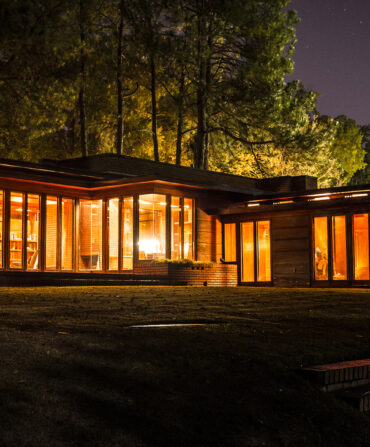To sit in a curlicued rattan chair is, in fact, to sit in the arms of a palm frond.
The lightweight rattan furniture that dots porches and sunrooms all over the South is made of a vining Old World palm plant that grows in rainforests. Once steamed or soaked, the dense canes are easy to shape into ornate or sleek tables, light fixtures, and peacock chairs.
“There’s something so visually cooling about rattan as a material—it looks light and airy,” says Lulu Lytle, who runs the rattan and furniture company Soane Britain and is the author of a beautiful and fascinating new book, Rattan: A World of Elegance and Charm. “Rattan is so immediately evocative of relaxation and warmth, and it can rotate between house, porch, and garden.”

In the seventeenth and eighteenth centuries, rattan vines were used as a loose packing material in cargo ships. (Quick point of clarification that Lytle explains in the book: Although “rattan” and “wicker” are often used interchangeably, rattan is a natural fiber, while wicker is the product of the craft of weaving, not only with rattan, but with other plant matter.) Early colonialists began shaping the materials into furniture when they realized the vines’ pest resistance and portability.
A wicker cradle arrived on the Mayflower in 1620, and Americans’ affair with the stuff began. In the 1800s, the Heywood-Wakefield Company’s catalog of wicker furniture started a boom that continues today, and industrialists began to popularize the furniture in the South. When the railroad tycoon Henry Flagler built up his Palm Beach, Florida, empire, the society set descended during the winter months, landing in rattan seats in sunrooms and enjoying tea around rattan tables. “Flagler banned motor vehicles on the island,” Lytle explains, “and guests were conveyed along a pine trail between two hotels in ‘Palm Beach Coaches,’ essentially rattan chairs attached to the front of bicycles.”

The allure of rattan extended into public spaces as well—the Taboo nightclub on Worth Avenue in Palm Beach overflowed with rattan chairs that seated the likes of John F. Kennedy and Frank Sinatra. “Even in the grandest Palm Beach mansions, rattan is and was used both inside and on porches.” Lytle says that while searching for photographs for her book, she realized a trend. “I have looked at thousands, and I mean thousands, of photographs of rattan in interiors, and I cannot find a single one where people are looking miserable,” she says. “Rattan humanizes even the grandest setting—it’s like the furniture is saying, sit back and have a drink.”

Perhaps no Southern tastemaker understood rattan’s comforting power better than Rachel Lambert “Bunny” Mellon. The designer of the White House’s Rose Garden, Mellon was also a philanthropist and art collector with a gorgeous Upperville, Virginia, estate. She was known not only for her immense wealth, but for creating exceptionally lovely but laid-back homes and gardens—with woven furniture and wicker baskets as some of her favorite props. The charming new book Garden Secrets of Bunny Mellon describes how Mellon so adored her garden containers that she had various follies and houses constructed to hold pots and baskets. “A slice of the Basket House pool fronts a sheltered niche,” the book explains before landing this achingly poetic blow: “Bunny dipped her baskets in the pool to refresh and clean them.”

“Bunny Mellon was so revered for her sense of aesthetics, and she always used fresh flowers, rattan furniture, and piles of books in this supremely elegant, understated way,” Lytle says, adding that Mellon was a pro at mixing woven furniture with fine art and antiques. “It’s hard to do comfortable and elegant really well, and she epitomized Southern taste.”
While Lytle has a soft spot for historic rattan (“Do any of your readers want me to help them restore a Palm Beach mansion’s worth of rattan?” she asks earnestly), she’s noticed a new audience of rattan lovers who are interested in its environmental benefits—“rattan cultivation doesn’t require deforestation,” she says—as well as its connection to craftsmanship and comfort through generations. “Rattan appeals to Southerners because they care so much about the way things are made.” Lytle says. “When someone sits in their favorite rattan furniture, they know their great-grandchildren will still be enjoying it.”









